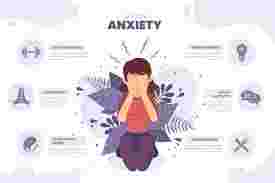Introduction
Anxiety affects both men and women, but women are nearly twice as likely to be diagnosed with an anxiety disorder. This difference is not just emotional or psychological — it's deeply rooted in biological, hormonal, and societal factors. From menstrual cycles to menopause, and from pregnancy to everyday social pressures, women face unique challenges that often remain hidden behind the curtain of daily life. Understanding the hormonal links and silent struggles can help break the stigma and pave the way for better support and care.
The Hormonal Connection to Anxiety
Estrogen and Progesterone Fluctuations
Female hormones like estrogen and progesterone fluctuate during the menstrual cycle, and these changes directly affect mood and anxiety levels. Estrogen, when balanced, has a calming effect on the brain. However, during premenstrual phases, its sudden drop can trigger mood swings, irritability, and anxiety.
Premenstrual Syndrome (PMS) and PMDD
PMS is well-known for causing mild emotional symptoms, but Premenstrual Dysphoric Disorder (PMDD) is a more severe form that includes intense anxiety, anger, and depressive episodes. Many women with PMDD experience panic attacks, irrational fears, and emotional overwhelm before their periods each month.
Pregnancy and Postpartum Changes
During pregnancy, hormone levels like estrogen and progesterone rise significantly, affecting the nervous system and mood regulation. After childbirth, these levels drop suddenly, contributing to postpartum anxiety. This form of anxiety is different from postpartum depression but can be equally debilitating.
Perimenopause and Menopause
As women approach menopause, their hormone levels fluctuate unpredictably. These shifts can trigger new or worsening anxiety symptoms, including palpitations, restlessness, and excessive worry. The psychological impact of aging, loss of fertility, and body image issues can further intensify anxiety during this time.
The Hidden Struggles Women Face
Social Expectations and Emotional Labor
Women are often expected to juggle careers, families, relationships, and emotional caretaking — all while maintaining composure. This constant emotional labor can lead to internalized stress and chronic anxiety, especially when support is lacking.
Stigma Around Expressing Emotion
Society often labels emotional women as “too sensitive” or “overreacting,” which discourages many from speaking openly about their anxiety. This suppression creates a hidden layer of suffering that worsens mental health over time.
Gender-Based Trauma and Abuse
Many women with anxiety have histories of trauma, including emotional or physical abuse, harassment, or assault. These traumatic experiences not only leave psychological scars but also trigger anxiety disorders like PTSD, social anxiety, and panic disorder.
The Pressure of Perfection
From beauty standards to professional excellence, women frequently face pressure to be perfect. Social media only adds to this, creating a comparison trap that fuels insecurity and anxiety, especially in younger women.
Recognizing the Signs of Anxiety in Women
Emotional Symptoms
Persistent worry, fear, irritability, and feelings of being overwhelmed are common emotional symptoms of anxiety in women. These may vary in intensity depending on hormonal cycles or life circumstances.
Physical Symptoms
Anxiety can manifest physically as headaches, muscle tension, fatigue, racing heart, or digestive issues. Many women experience these symptoms without realizing they are anxiety-related, leading to frequent doctor visits with no clear diagnosis.
Behavioral Changes
Avoiding social interactions, overworking, perfectionism, and withdrawing from loved ones are signs that anxiety may be taking over a woman’s life. These behaviors often go unnoticed or are mistaken for personality traits.
How Women Can Manage and Reduce Anxiety
Hormonal Awareness
Tracking menstrual cycles and understanding hormonal patterns can help women prepare for emotional fluctuations. Apps and journals can be useful tools for recognizing patterns and triggers.
Therapy and Professional Support
Cognitive Behavioral Therapy (CBT), talk therapy, or trauma-focused therapy can help women identify and manage anxious thoughts. Therapists who specialize in women’s mental health can provide targeted strategies.
Lifestyle Adjustments
Regular exercise, a nutritious diet, and adequate sleep all play key roles in reducing anxiety. Activities like yoga, meditation, and deep breathing help regulate stress hormones and calm the nervous system.
Medication When Needed
In some cases, anti-anxiety medications or hormone therapy may be recommended by healthcare providers. These should always be prescribed and monitored by professionals.
Building a Support System
Talking to trusted friends, joining support groups, or finding online communities for women with anxiety can offer emotional relief and a sense of solidarity.
When to Seek Help
If anxiety is interfering with your work, relationships, or daily life — or if it is linked to hormonal changes like PMDD or postpartum — it’s essential to seek professional help. Early intervention can prevent anxiety from becoming chronic or escalating into depression.
Conclusion
Anxiety in women is more than just occasional stress or overthinking — it's often tied to complex hormonal and societal factors. Recognizing the unique struggles women face and addressing the biological roots of anxiety can lead to more effective treatment and compassion. By breaking the silence, raising awareness, and seeking the right support, women can regain control over their mental health and thrive in every stage of life.
References:




